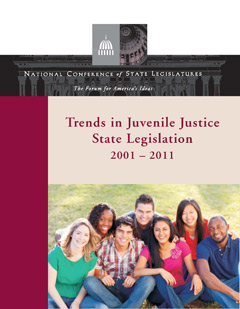Recently, the National Conference of State Legislators published Trends in Juvenile Justice State Legislation 2001-2011, a decade-long analysis of changes that have occurred to the nation’s juvenile justice system.
The report, funded by the John D. and Catherine T. MacArthur Foundation, states that a decrease in juvenile crime rates has shifted states towards a greater emphasis on rehabilitative services, with more states reexamining stringent juvenile justice policies established in the 1990s.
 “Today, more and better information is available to policymakers on the causes of juvenile crime and what can de done to prevent it,” the executive summary of the report reads. According to the analysis, several factors — including newfound information about the neurobiological development of adolescents, research-tested competency statutes and increased use of evidence-based, youth intervention programs — has led many state policymakers to pursue legislative changes that continue to distinguish juveniles from adult offenders.
“Today, more and better information is available to policymakers on the causes of juvenile crime and what can de done to prevent it,” the executive summary of the report reads. According to the analysis, several factors — including newfound information about the neurobiological development of adolescents, research-tested competency statutes and increased use of evidence-based, youth intervention programs — has led many state policymakers to pursue legislative changes that continue to distinguish juveniles from adult offenders.
Additionally, researchers say that more states are restoring the jurisdiction of juvenile courts, implementing scientific screening and other assessment tools to determine the needs of juvenile offenders and increasing due process protections for youth. The analysis also notes that, over the last 10 years, more efforts have been made to address detention reform and racial disparities within the nation’s juvenile justice system.
Researchers say that budgetary issues have led to many states reassessing their juvenile justice systems, resulting in more states shifting financial resources from incarceration to community-centered services, such as evidence-based intervention programs.
The report charts the changes in federal juvenile justice standards over the last 10 years, from the 2005 Roper v. Simmons Supreme Court ruling that banned juveniles from being sentenced to death for offenses committed before they reached 18 years of age to this summer’s Miller v. Alabama holding, which made mandatory life without parole sentences for juveniles unconstitutional.
The analysis states that over the last decade, more states have placed an emphasis on addressing the mental health needs of juvenile offenders. In 2005, Texas legislators required juvenile probation departments to utilize MAYSI-2 screenings to identify potential substance abuse issues or mental health needs for offenders, while in 2009, North Dakota and Oregon legislation required youth that committed alcohol-related violations to undergo drug and alcohol education and treatment services.
Regarding detention and corrections reform, the report states that the average length of incarceration for juvenile offenders has been reduced to 15 or fewer days, with more risk assessment instruments being used at detention admission screenings to determine offender treatment needs.
While juvenile crime rates have fallen over the last decade, the report notes that more females are entering the juvenile justice system, making up 15 percent of the nation’s total juvenile justice population. As a result, several states, including Connecticut, Florida, Hawaii, Minnesota and Oregon have enacted gender-specific programming legislation that provide services and treatments for the growing population, which accounts for as much as 34 percent of the total juvenile justice populations in some states.
More aftercare services are being established for juveniles recently released from corrections facilities and other out-of-home placements, according to the report. Maryland legislation from 2004 required “step-down aftercare” to meet the individual rehabilitation needs of returning youths, while aftercare legislation in Colorado, Indiana, Ohio and Mississippi all created or promoted the establishment of community-based reentry services for juveniles.
The report concludes by noting the positive impact cross-systems collaboration and multi-system coordination has had on preventing and addressing juvenile crime in the United States.
“The legislative trends evidenced during the past decade reflect a new understanding of adolescent development and the value of cost-benefit analysis of existing data-driven research,” the report’s conclusion reads. “States are not complacent about juvenile crime and remain interested in providing public safety, improved juvenile justice systems and positive results for youth.”































